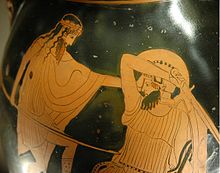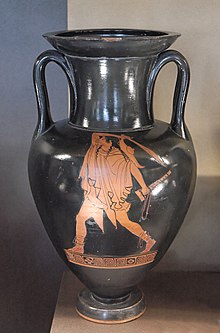Makhaira

Themakhairais a type ofAncient Greekbladed weapon and tool, generally a largeknifeorsword,similar in appearance to the modern daymachete,with a single cutting edge.
Terminology
[edit]
The Greek word μάχαιρα (mákhaira,pluralmákhairai), also transliteratedmachairaormachaera,is related toμάχη(mákhē) "a battle",μάχεσθαι(mákhesthai) "to fight". It derives from theProto-Indo-European*magh-.
Homermentions the makhaira, but as a domestic knife of no great size.[1]In period texts, μάχαιρα has a variety of meanings, and can refer to virtually any knife orsword,even a surgeon'sscalpel,but in a martial context it frequently refers to a type of one-edged sword; a sword designed primarily to cut rather than thrust.[2]
TheKoineof theNew Testamentuses the wordmakhairato refer to a sword generically, not making any particular distinction between native blades and thegladiusof theRomansoldier.This ambiguity appears to have contributed to the apocryphalmalchus,a supposedly short curved sword used byPeterto cut off the ear of a slave namedMalchusduring the arrest ofJesus.While such a weapon clearly is amakhairaby ancient definition, the imprecise nature of the word as used in the New Testament cannot provide any conclusive answer.
Makhairaenteredclassical Latinasmachaera,"a sword". Thedimachaeruswas a type of Roman gladiator that fought with two swords. Inmodern Greek,μαχαίριmeans "knife".
Modern scholars distinguish the makhaira from thekopis(an ancient term of similar meaning) based on whether the blade is forward curved (kopis), or not (makhaira).[3]
Characteristics
[edit]
Makhaira were of various sizes and shapes, being regional, and not exclusively Greek.Greek artshows theLacedaemonianandPersianarmies employing swords with a single cutting edge, but Persian records show that their primaryinfantryswordwas two edged and straight, similar to the Greekxiphos(cf.acinaces). Greek vase painting begins to show makhairai very infrequently fromc. 530 BC,though their depiction is increasingly common on 'red figure' ceramics fromc. 510 BConwards.
The makhaira depicted in artworks was single-edged, having an expanded convex portion to the cutting part of the blade towards its tip. This concentrated weight, therefore momentum, to this part of the blade; facilitating particularly forceful cuts. The shape of the blade allowed the makhaira the potential to cut through bone.[4]
Despite their relatively frequent depictions in art, archaeological remains of this type of sword are rare.[5]
Use
[edit]
WhileXenophonstates that the xiphos was the conventional sword used by theGreek soldierof his time, he recommended the makhaira forcavalry."I recommend akopisrather than axiphos,because from the height of a horse's back the cut of amachairawill serve you better than the thrust of axiphos."(Xenophon, 12:11).[6]Archeological evidence suggests that the makhaira was more predominant in areas that were not so focused on using thephalanx,and instead focused more on cavalry.[7]
His reasoning concurs with the general practice of arming cavalry with cutting swords through the ages. Greek art along with Xenophon's further commentary suggests that the sword he intended for the cavalry was wider than the more modernsabre;more akin to thefalchionor evenmachete.
See also
[edit]- Falcata
- Kopis
- Sica
- Xiphos
- Kukri
- Sword classificationis not always exact and can change over time and between cultures.
- Machaerus,military outpost of the Hasmoneans
Animals
[edit]There are examples of animals that havemakhairaormachairain their names.
References
[edit]- ^Gordon, p. 24
- ^For a good summary of the evidence, see F. Quesada Sanz: "Máchaira,kopís,falcata "inHomenaje a Francisco Torrent,Madrid, 1994, pp. 75-94.
- ^Tarassuk & Blair, s.v. "kopis,"The Complete Encyclopedia of Arms and Weapons,1979.
- ^MOLLOY, BARRY (2010)."Swords and Swordsmanship in the Aegean Bronze Age".American Journal of Archaeology.114(3): 403–428.doi:10.3764/aja.114.3.403.ISSN0002-9114.JSTOR25684288.S2CID163287941.
- ^Gordon, p. 24
- ^Sidnell, P. (2006)Warhorse: Cavalry in Ancient Warfare.Continuum International Publishing Group, pp. 33-34.
- ^Mödlinger, Marianne (2015)."Review of Die barbarischen Einflüsse in der griechischen Bewaffnung. Internationale Archäologie 125, Marek Verčík".Archaeologia Austriaca.99:259–264.doi:10.1553/archaeologia99s259.ISSN0003-8008.JSTOR43955762.
Bibliography
[edit]- Gordon, D.H. (1958)Scimitars, Sabres and Falchions.in Man, Vol 58, Royal Anthropological Institute of Great Britain and Ireland.
- Liddell & Scott.A Greek-English Lexicon,9th edition, 1996.
- Xenophon,On Horsemanship.
- F. Quesada, Machaira, kopis, falcata=https://web.archive.org/web/20090219135233/http:// ffil.uam.es/equus/warmas/online/machairakopisfalcata.pdf
